Finally we have the chance to test the long awaited and much anticipated Kia Stinger GT Sport. The general feeling around the office was this: it’s going to be an exciting one, and we hoped that the Stinger performed as advertised and looked just as good in real life as it does in photos.
The Range
The range is simple with 3 models available in New Zealand. The Kia Stinger EX Turbo is available from $54,990, the GT Line from $59,990 and the GT Sport from $69,990. All three models are rear wheel drive and come with an 8-speed automatic with shift by wire transmission.
There are 6 colours to choose from, Snow White Pearl, Hi Chroma Red, Aurora Black, Deep Chroma BLue, Silky Silver and Panthera Metal.
The EX Turbo has a 2.0L turbocharged inline 4 Theta II engine. This produces 182kW of power and 353Nm of torque. Kia states a 0-100km time is 6.0 seconds and a combined fuel economy of 8.8L per 100km. It comes as standard with a leather interior, 7” touchscreen display, heated and cooled seats, memory seats, wireless charging pad, dual-zone climate control, proximity key, push button engine start and stop, Apple CarPlay, Android Auto, paddle shifters, smart cruise control, LED headlights, 18” alloys and quad exhausts.
The GT line has everything that the EX Turbo has with a few extras. It’s even running the same engine as the EX with the same power, torque, performance and economy figures. The GT line upgrades to an 8” touchscreen, powered tailgate, adaptive LED headlights, 19” alloys, electronic adjustable suspension and heads up display.
The GT Sport is different, as it does not share the same engine. The GT Sport has a 3.3L Twin Turbo V6 Lambda II engine. Which produces 272kW and 510Nm of torque. Kia states a 0-100km time is 4.9s and a combined fuel economy of 10.2L per 100km. This GT Sport has everything available from the GT line, and also comes with, unique GT Sport 19” alloys, Brembo front and rear brakes, Harman/Kardon sound system, power sunroof, adjustable seat bolster system and launch control.
The options available for the Stinger are also rather simple. You can upgrade to a Bi-modal exhaust system for $2,750, towbar for $735, roof racks for $483, carpet mats for $200, carpet liner for $200 and a cargo mat for $200. All of these options are exclusive of GST.
Disappointingly our test car did not have the optional Bi-modal exhaust system.
First Impressions
As I jumped out of the taxi I took to get to the local dealer, I saw a red Stinger GT Sport with the plate Kia GT. That must be it. Once I spoke to our contacts, they confirmed it was.
Internally my mind was struggling to work out what was going on. I was looking at a beautifully designed, visually strong and sporty car, and a Kia at the same time. But it looked so good in person, and that red was perfect for it.
Now before you get your pitchforks and light your torches, let’s be fair. Kia are not exactly known for exciting, powerfull or crazy cars are they? No they are not, but I will give credit where credit is due. Over the last 5 years Kia have really stepped up their game and now offer a rather good looking lineup of vehicles. But just so we’re clear, I don’t have a hate on for Kia, I am just saying it like it is. I hope that the Stinger is the start of what could become an exciting sporty future.
As for my first impression in the flesh, I loved it.
The Inside
The interior is rather nice, and well laid out. Not too much clutter, a clever use of the space available. Take the badge off the steering wheel, and you’re sitting in what could be a European car: nice soft touch materials and sleek brushed aluminum inlays, all coming together in what feels like a luxurious environment.
The seats looked great too, contoured sporty design, finished with a ultra soft nappa leather, only available on the GT Sport. But are they any good? I am a big, tall guy and still found them to be both comfy and supportive. The GT Sport is upgraded with the driver’s seat bolster adjustment, controlled by pressurised air cells. They were really nice and oddly enough the headrest was too. Normally just a large bit of leather covered foam, but these headrests had a soft padded section in the middle which cushioned your head, instead of just resting against it. I know – hard to explain, try it when you jump in one. The heated and cooled seats were pretty good too. The heating took a while to fire up, maybe a minute, but once going it was a very even and strong heat across your bum and back.
The rear seats were just as comfy, but the space was a little on the tight side in the foot well, if the driver is tall like I am. The rear of the car can be a bit dark, even with the panoramic sunroof cover open. My wife said it was ok when in the back with our baby, but it was noticeablely darker then the front of the cabin. The sunroof was a nice touch too, again standard. You could have it closed with a blackout cover in place, open the cover, tilt open the roof and full slide back the roof. The buttons for this where a bit tricky. The normal trigger switch had 4 settings: two forward and two back. Half press made one action, like opening the blackout cover, and a full press opened the tilting sunroof completely. Same in reverse, something I am sure owners would get used too.
The centre dash console’s main feature is an 8” touch screen display, with 3 air vents under this, followed by two rows of buttons, that gave you access to the radio, media, track selection, hazard lights, map, nav, setup and a Favourites button. Under this was the second row which had the standard air circulation and climate controls. If we keep going down, we have a wireless charging pad, USB, AUX and 12V socket all hidden under a clean sliding cover.
What I found odd was that lack of any sort of dail or toggle to control the media screen from your left hand. Usually in many cars this is near the gear stick, and over time you get used to the movements, which become engrained, so you don’t even need to look at what you’re doing. Not a biggy, but odd, maybe I just needed more time with it.
As I tested it more, I found that there is no button for phone on the centre console. It’s on the steering wheel, or by using the touch screen. That’s it. I personally found the whole menu system a bit off, maybe it’s just not in line with my thinking, but it felt like it could have been setup to be more intuitively.
Two things bug me on the inside of the Stinger. The first is the steering wheel; it would appear that the airbag cover is from the standard Kia range of covers. What I mean by this is that it does not appear to blend in with the soft touch materials all around it. It has a sort of shiny plastic look and feel to it. Which is a shame, as the rest of the interior is so nice.
And the second is the memory functions for the seats. This is a first for me, maybe other Kias have this, but you can’t change and save your setting unless the vehicle is in Park. I can somewhat see why they did this, but no one else does, because it’s just a bit ridiculous.
What I did like was the key. I have to hand it to Kia here – well done on making something a bit more interesting than a regular old key fob. Nice design, with a side featured lock car button which was super easy to feel when it’s in your pocket.
The boot is ok, maybe a bit on the small size at 406 litres, which feels like a lot, but the boot is not that deep inside. When you lift the cover, the space saver spare wheel takes up a lot of space, which I feel could have been more beneficial as depth. We found it hard to fold a buggy down into this boot, and get anything else in there with it.
The Drive
From behind the wheel of the Stinger you immediately have a sense this its been tuned for performance driving. The steering is really sharp, even with Eco and Comfort modes, there is little or no play in the steering wheel. I was surprised how sharp it was, because it became even more aggressive in Sports mode, leaving the driver with pin point accurate steering. The only downside to this is that there is zero play, even a slight rotation in the wheel will change the path of the car. Great for when you are 100% focused and looking for that hardcore driving experience. But when you’re cruising, I did find that It took me a while to get used to it. Lots of corrections to make up for the extra degrees I was moving the wheel. Over the course of the review this start to become more natural, so I don’t think it will be an issue for many owners.
The Stinger GT is equipped with a wide range of driver aids. Smart cruise control, blind spot detection, forward collision warning system, rear cross traffic alert, lane keep assist, driver attention warnings, high beam assist and autonomous emergency braking. An impressive line up of standard options I must say.
As you can imagine it can be hard to test some of these features in a safe environment. However I did get to experience the rear cross traffic alert, and I was impressed with how far the vehicle was away when the alert started to ring out. Very handy feature especially as the rear roof/boot pillars are bulky.
The smart cruise control worked well in most cases, only having some momentary issues with vehicles in lane beside me heading around a curve on the motorway. The system would ease off the power, and then continue on once the system was happy the car was not crossing into the lane ahead. Again I was impressed with the distance it was able to make these decisions.
I did not find the lane keep assist as helpful as the other aids, and this was mostly due to the sharp steering setup. I found that the lane keep assist was a bit jerky with its movements, and after a bit of time, this just put me off using it altogether.
Another surprise was the rear parking camera and 360 degree top down camera. Both of which worked very well with the parking sensors as a final line of defence. I had to keep looking at what was optioned and what was standard, as it was not adding up. These things don’t come cheap on most cars. But I guess the Kia Stinger is not most cars.
Fred from DriveLife would be happy with the Auto Hold feature. It works just how he likes, once active, when you come to a stop it engages. And you can lift your foot off the brake too, the car won’t move until you tap on the accelerator to move off. I did however have trouble working out how to leave this on. As it seemed to reset each time I started the car. Hopefully there is a more permanent menu for this somewhere.
The Stinger offers a selection of drive modes: Smart, Eco, Comfort, Sport and Custom. Most of these do exactly what they say they will, and with most cars I find myself driving in Comfort or Sport for the majority of the review.
Covering off what each of them do, Smart mode as it would suggest: looks at your current driving requirements and provides the best mode the computer feels you need. It may even over time look at your driving style, but I not 100% sure. If someone has one, let us know.
Eco was not as I would have imagined. Usually Eco is a very limp-wristed version of Comfort that’s trying to force you to drive slower and use less fuel. I did not find that with the Stinger, and surprisingly found myself driving in Eco most of the time. It just felt right for this type of car.
Comfort did not have a noticeable difference from Eco, unless you were changing while accelerating. And even then the difference was slight. I was hoping that Eco would conserve more fuel, so I stuck with that.
Sport had a noticeable difference, with four aspects changing instantly. The sound, the power, the steering and the ride, all of which were turned to 11. This is where the Stinger’s hidden fire was lurking. You now have the full power of the engine at your command with a super-sharp throttle response. The suspension was stiffened, and ready for action. The steering sharped even more and if I was not aware this Stinger did not have the Bi-Modal Exhaust I would have said that it was switched on. The engine’s roar become increasingly more aggressive in this mode.
Last but not least we have Custom, which lest you play around with all of the settings that change in Sport, allowing you to keep the suspension stiffer while having the steering in Comfort mode. Or even just having the noise from the engine louder.
Ok, there’s one other thing that bugs me. For anyone who has read my previous reviews, I have a thing about making simple features more exciting. For instance the push button start and stop button with sporty cars – it would not cost much to make this button a bit more exciting. This button did not bug me as much as the drive selection dail. It was a bit dull considering the car it was linked to. Even the button right below it for the seat heating and cooling modes had more excitement to it. It’s not hard and yes, I’m being picky, but the dail is dull and this car is not; please make something cooler.
I must not forget the HUD and yes, it’s standard. Nothing too fancy, it displayed the relevant info, mainly speed in the windscreen. It was so subtle that I hardly knew it was there, but used it all the time. Kia didn’t opt for a plastic pop up screen, they went the whole way, with e lcd image reflected into the windscreen. I guess if your going to do a job, might as well just do it right.
I am convinced that the GT Sport has some sort of torque vectoring differential. There is nothing that I can find on Kia’s website or in any of the documentation that I had available. The only thing mentioned is a limited slip differential. What I am experiencing seems more advanced that a typical LSD. I noticed this right from the first drive, that the was something aiding the rear of the vehicle around corners and under heavy power. At first I thought rear wheel steering, but that would not make much sense. When in Sport and the accelerator pedal is flat to the floor, instead of just spinning out, it’s sending the power to whichever wheel has the most grip. Sounds like an LSD, but it’s more advanced as I can feel it working even on slow bends or tight corners, where it’s aiding the rear of the car around the corner. I have experienced a system like this before on the Lexus RCF and it was very impressive. But the Lexus was over twice the price of the Stinger GT, so it should have some crazy cool and expensive tech. Once you know its there, you start to explore its ability. In Sports mode the engine’s 510Nm are coming through the rear wheels: a bit mad, but a lot of fun. And when you have the support of a fancy diff, much safer fun.
During the week I had the Stinger GT Sport, there was a lot of rain. And in most cases you really don’t want to get too wild with a powerful rear-wheel drive car, as it would result in a photo being posted on our social media networks, about some moron who didn’t drive to the conditions. However, after a bit of testing, I was amazed at how much power you could deploy in a corner in the wet. The rear of the car would instantly lose traction, and enter a semi drift state where the diff was adjusting power to keep the car going where you want it to, without ending up in a ditch. Paired with the super-sharp steering, this car lets you have all the control, while letting it hang out a little too. The result, as you can imagine, left a massive grin on my face.
Once you have the Stinger back in a straight line and you apply the power, the roar that goes through the cabin is perfect. It has the right tone and grumble to it; not a traditional V6, not a massive V8, but somewhere in between. It’s the kind of sound that makes you want to hold the pedal down, and just keep going and going. But thanks to the 272kW and 510Nm you hit the speed limit in 4.9 seconds. Yes, this is a sub 5 second to 100km/h Kia.
Let’s put that into perspective for a minute. My daily driver is a 2009 Audi RS6, which has a twin turbo V10 from the Lamborghini Gallardo. This engine produces around 420kW and 500Nm of torque and can do 0-100 km in 4.5 seconds. It was the world’s fastest wagon in its day, and it’s still considered to be pretty damn fast now. But wait, specs like this don’t come cheap, and when new the V10 Audi RS6 was $300k. The $70k Kia Stinger GT Sport is almost as fast, a little bit more fun and a hell of a lot cheaper to buy.
This car surprised me again. Where has this dark side of Kia been all these years? And whatever you’re doing, please, can we have more.
The Competition – Mid Size Performance 4 Door Sedans / Coupes
This was where I got a bit stumped. The Kia Stinger GT Sport is a sub-5 seconds sports fastback, which is not something you often see in the price bracket they are offering the GT Sport. Also the engine specs are rather uncommon for that market segment too. So this list is made up a few odds and ends, keeping with 4 or 5 doors and similar performance specs.
| Brand/Model | Engine | Power/Torque | 0-100km/h, seconds | Seats | Fuel, L/100km | Boot Space, Litres | Price Highest to Lowest |
| BMW 440i M Performance | 3.0L V6 twin turbo | 265kW/ 500Nm | 4.9 | 5 | 6.8 | 445 | $118,800 |
| Mercedes-Benz CLA 45 AMG | 2.0L I4 Twin Turbo | 280kW/ 475Nm | 4.9 | 5 | 7.4 | 470 | $112,200 |
| Audi RS3 Sedan | 2.5L I5 TFSI | 294kW/ 400Nm | 4.2 | 5 | 8.4 | 280 | $106,900 |
| Lexus IS 350 F Sport | 3.5L V6 Turbo | 233kW/ 378Nm | 5.9 | 5 | 9.5 | 453 | $99,900 |
| Jaguar XE S | 3.0L Supercharged | 280kW/ 430Nm | 5.0 | 5 | 8.1 | 455 | $89,900 |
| Alfa Romeo Giulia Veloce | 2.0L I5 TFSI | 206kW/ 400Nm | 5.7 | 5 | 6.1 | 480 | $89,900 |
| VW Arteon TSI R-Line | 2.0L I4 Turbo | 206kW/ 350Nm | 5.6 | 5 | 7.3 | 563 | $76,990 |
| Kia Stinger GT Sport | 3.3L V6 twin turbo | 272kW/ 510Nm | 4.9 | 5 | 10.2 | 406 | $69,900 |
| Holden VXR Liftback | 3.6L V6 | 235kW/ 381Nm | 6.9 | 5 | 9.3 | 490 | $67,990 |
| Toyota Camry V6 | 3.5L V6 | 224kW/ 362Nm | 6.5 | 5 | 8.9 | 524 | $47,990 |
The pros and cons
| Pros | Cons |
|
|
What we think
Let’s even forget for a second at how well it drives. The value is mind-boggling; that engine, slick design, nice interior and packed with toys. It’s providing a European performance car experience, but all for under $70,000. Amazing.
Over the years, DriveLife has reviewed hundreds of vehicles. And a large majority come and go and are quickly forgotten. A smaller majority of these we really like, and a tiny selection of those, have a lasting impression on us. The Kia Stinger GT Sport has now gained access behind this velvet rope.
You might be thinking, John, don’t forget this is a Kia you’re talking about. Yes, I know, and that’s what’s so damn exciting about it. For me, it now sits beside the BMW M2, VW Golf GTi 40th Edition and Aston Martin V12 Vantage S, all of which have left an unforgettable impression of driving pleasure with me.
This car surprised me. I was expecting it to be good, but not this good. Nice work KIA.
Rating – Chevron rating (5 out of 5)
2018 Kia Stinger GT Sport
| Vehicle Type | Performance Sedan/Fastback |
| Starting Price | $69,990 plus on-road costs |
| Tested Price | $69,990 plus on-road costs (factory options only) |
| Engine | 3.3L Twin Turbo V6 Lambda II |
| Power Kw / Torque Nm | 272kW/510Nm |
| Transmission | 8-speed automatic with shift by wire transmission |
| 0 – 100 kph, seconds | 4.9 |
| Spare Wheel | Space saver |
| Kerb Weight, Kg | 2185 |
| Length x Width x Height, mm | 4830 x 1870 x 11400 |
| Fuel Tank, litres | 60 |
| Fuel Efficiency | Advertised Spec – Combined – 10.2L / 100km
Real World Test – Combined – 11.4L / 100km Low Usage: 0-6 / Medium Usage 6-12 / High Usage 12+ |
| Towing | 750 kg unbraked, 1500 kg braked |
| Turning circle | 5.6 m
Small: 6-10m / Medium 10-12m / Large 12m+ |
| Warranty | 5-year warranty or up to 100,000 km, whichever occurs first. |
| ANCAP Rating | 5 Star |


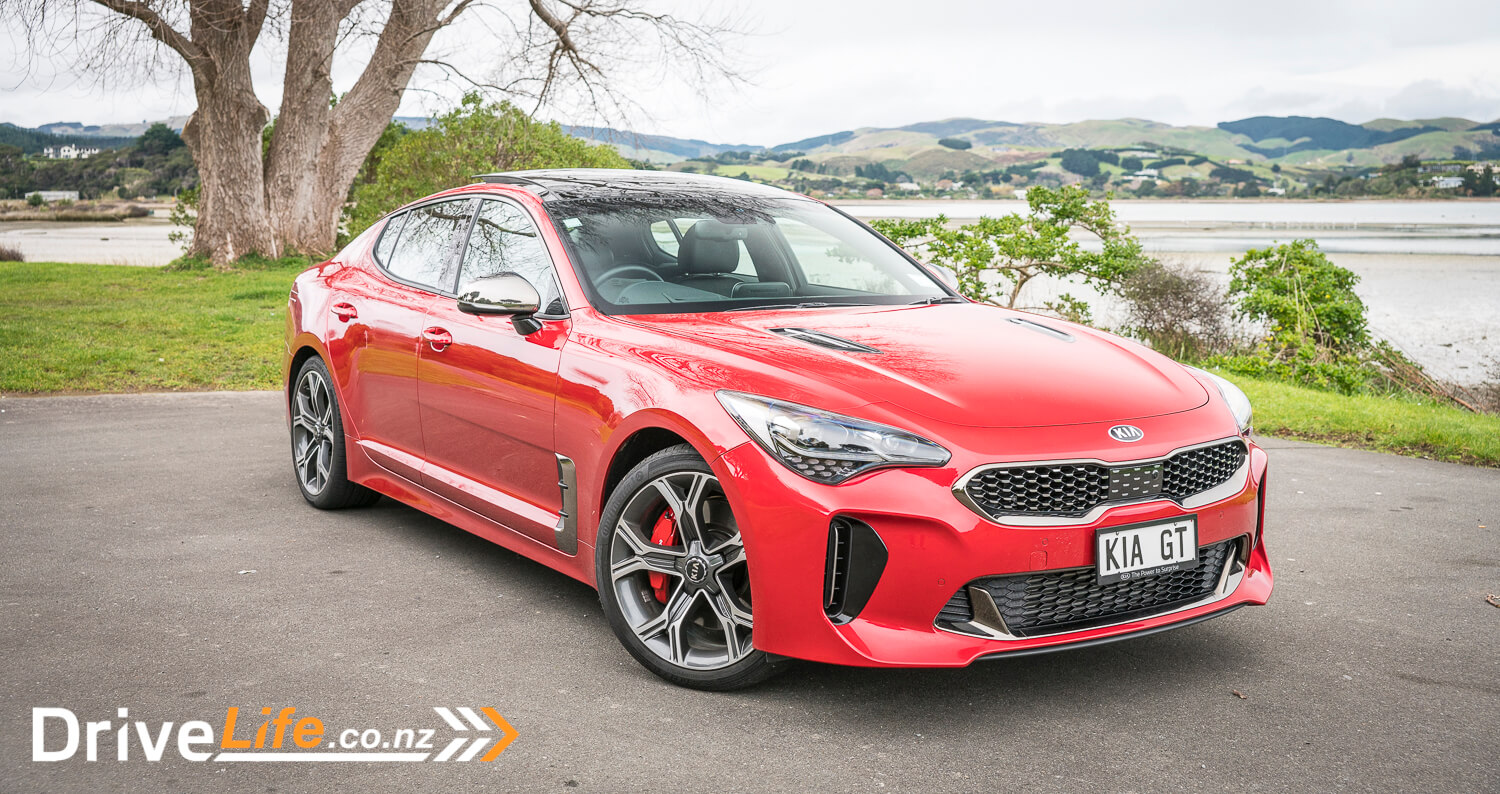
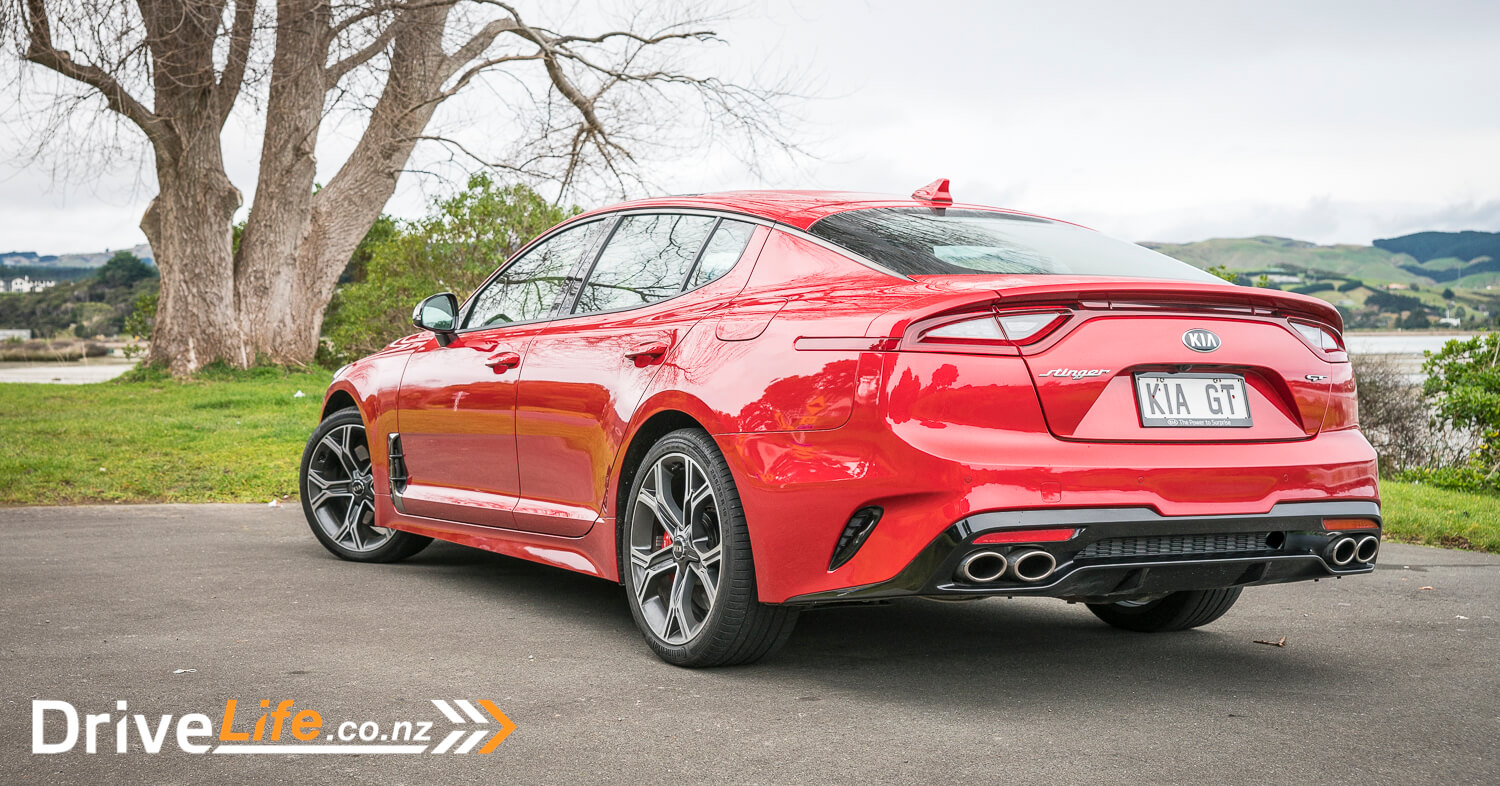
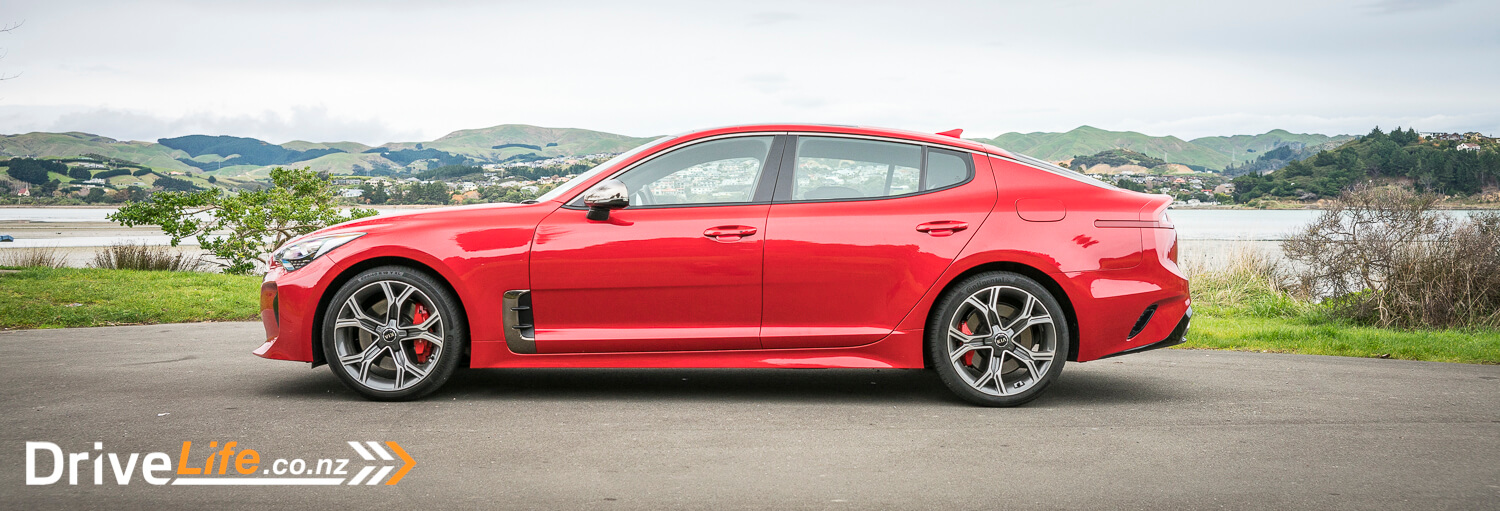

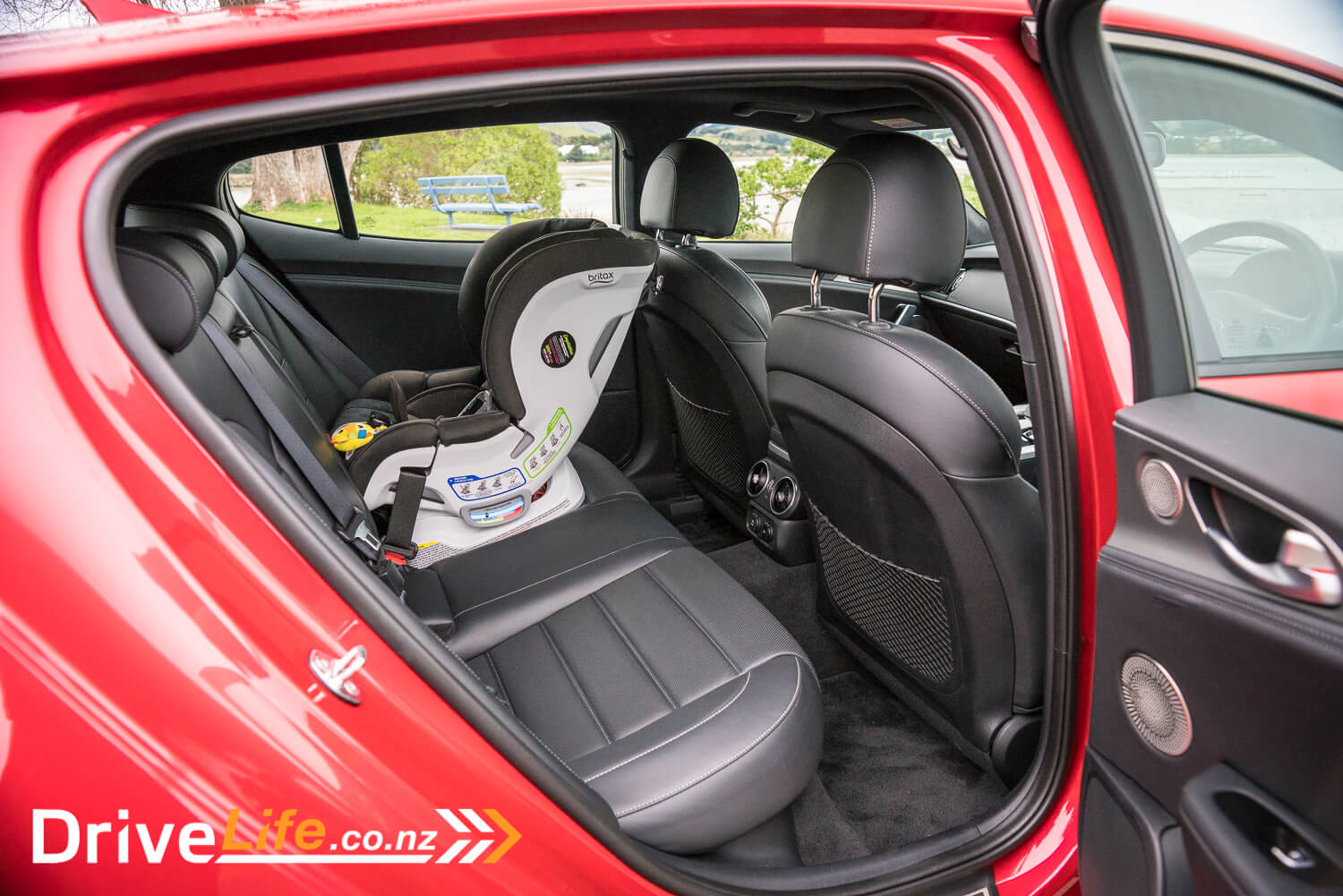
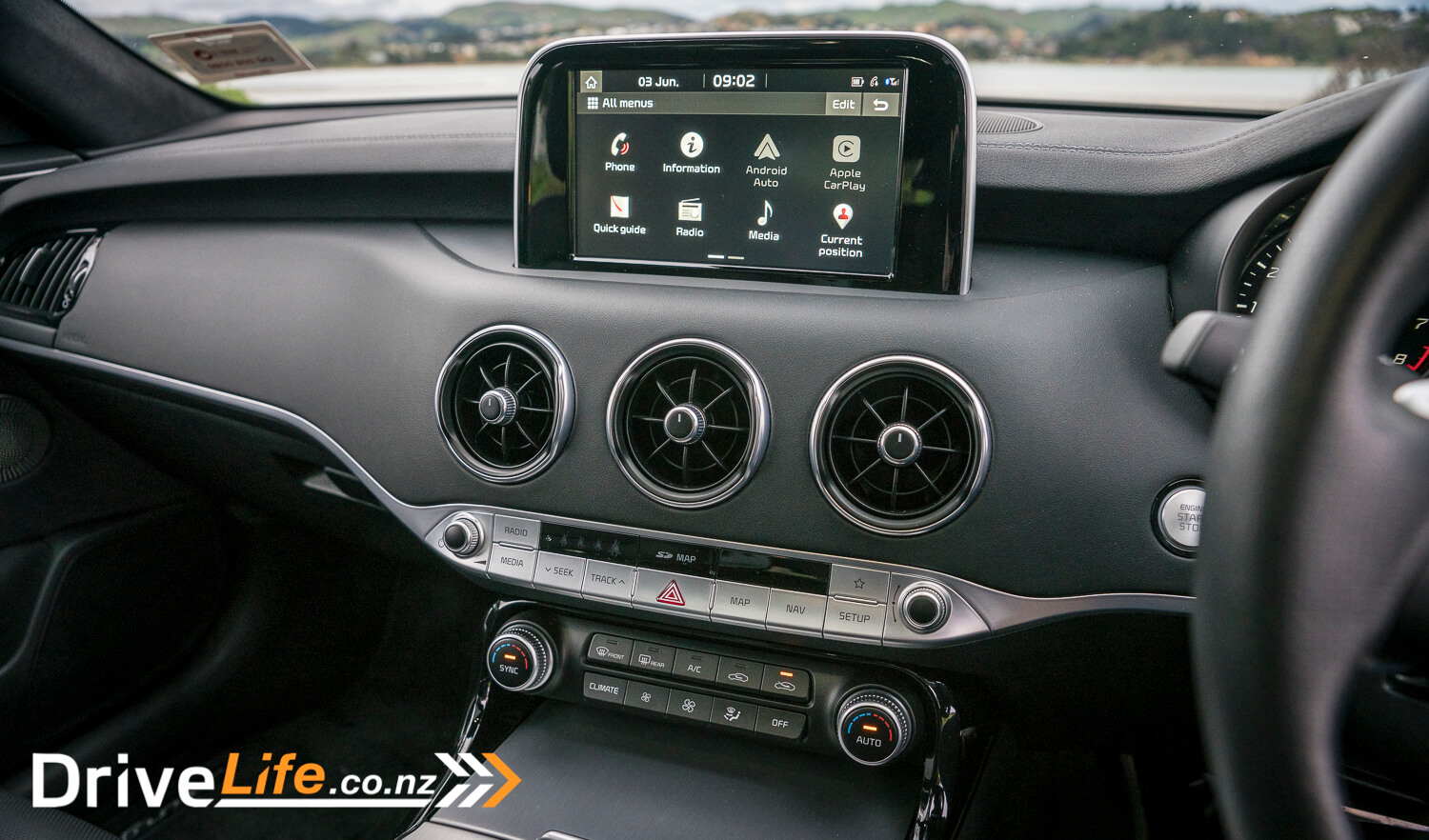
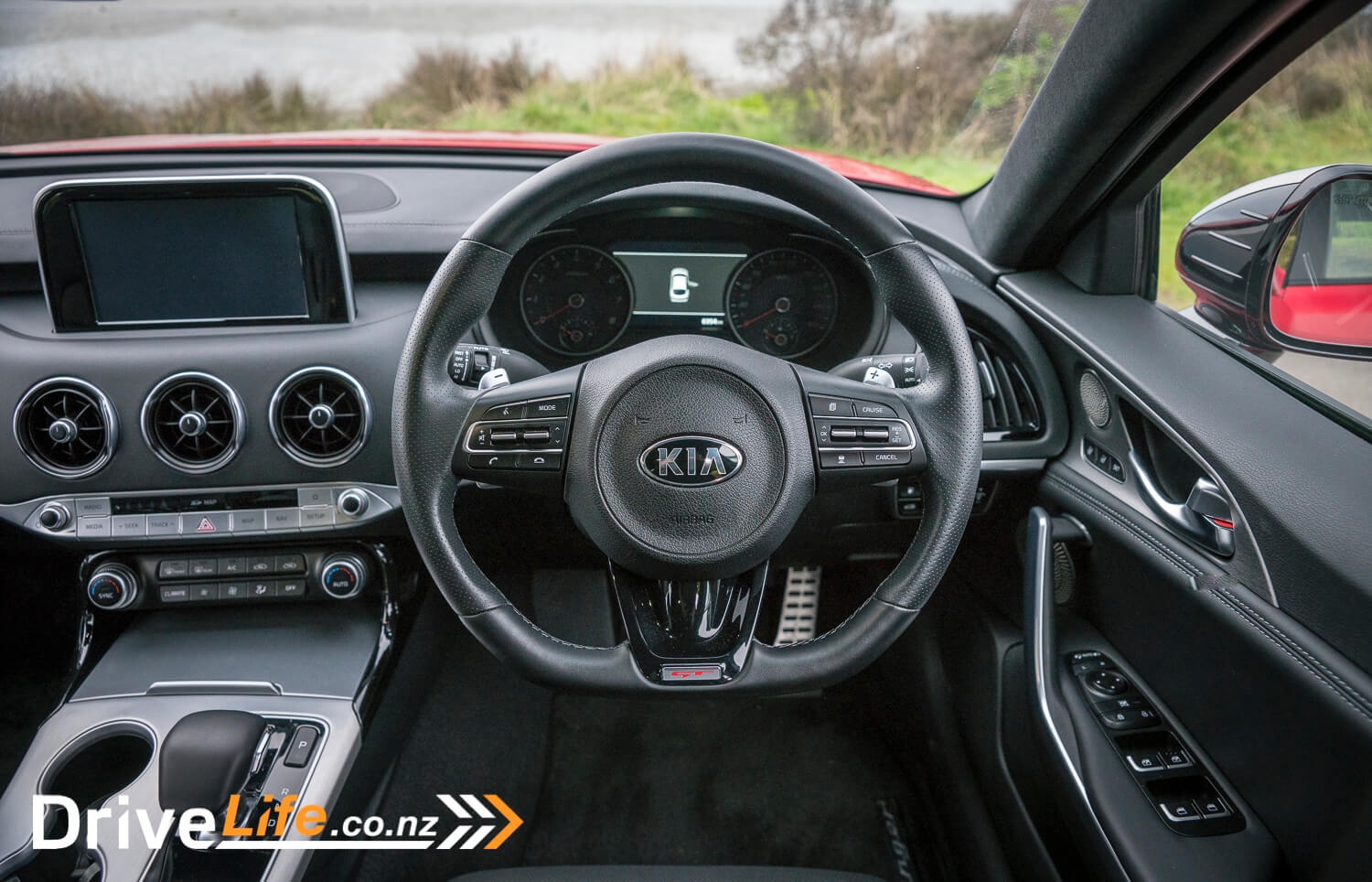
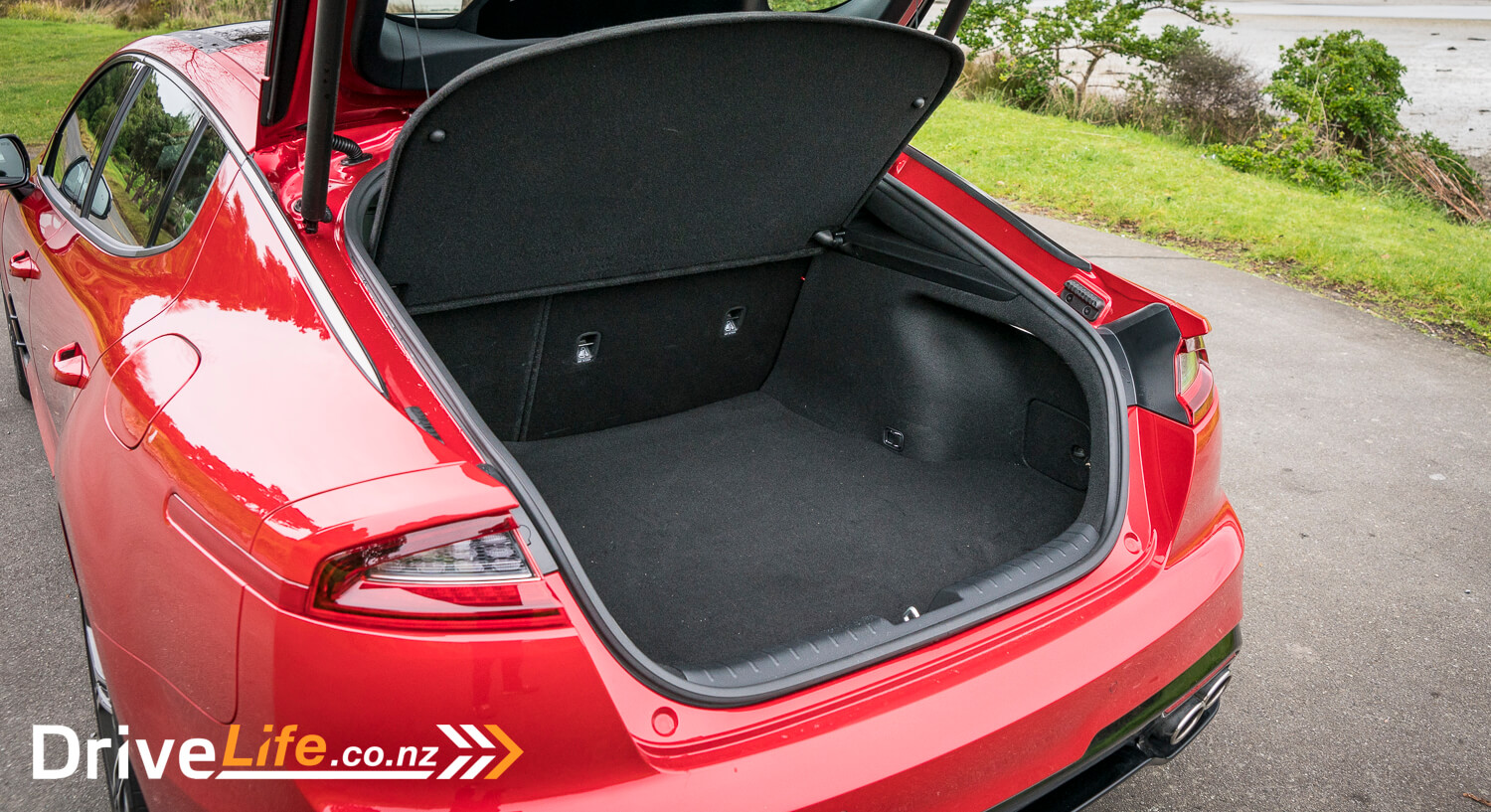

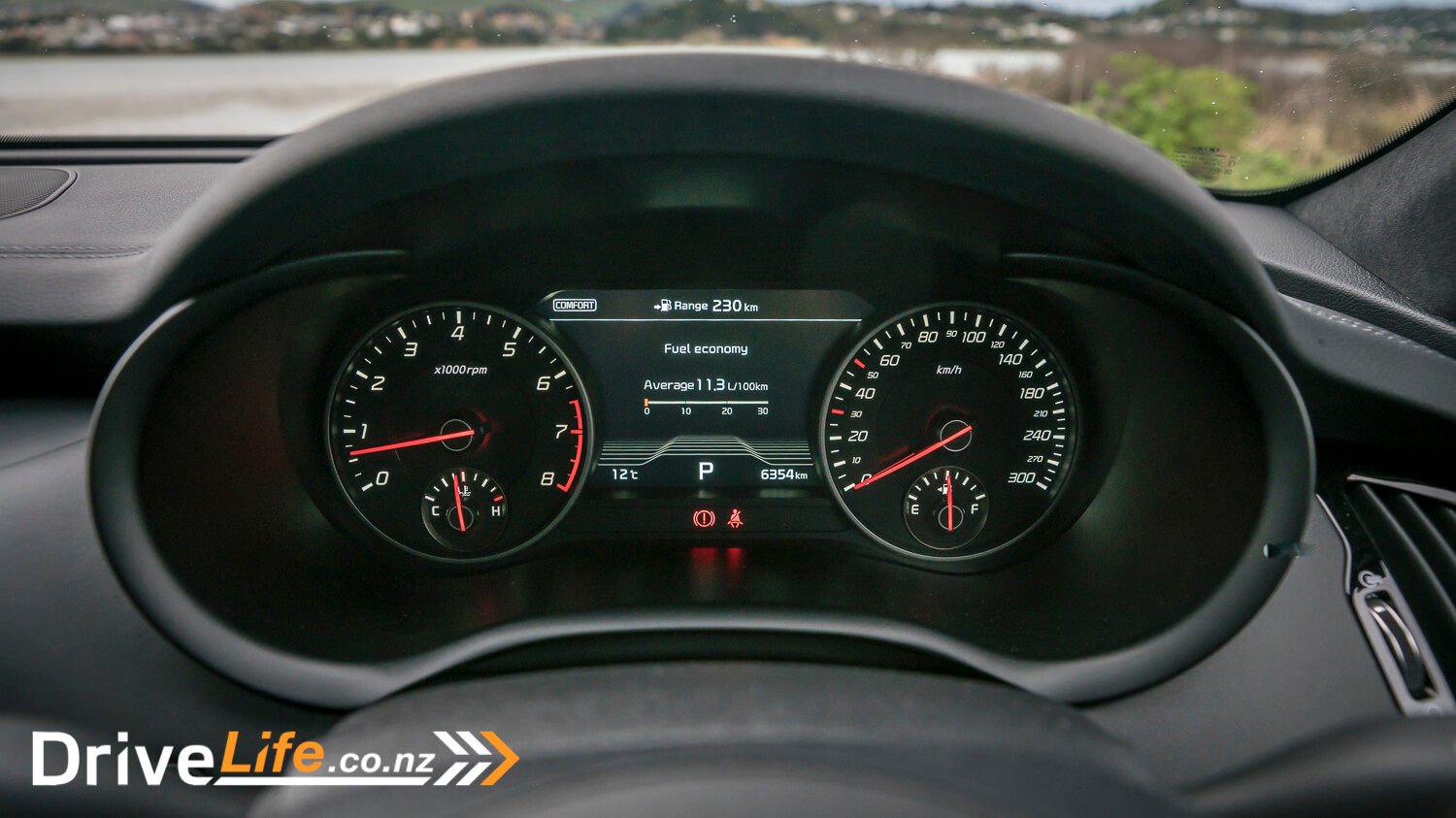
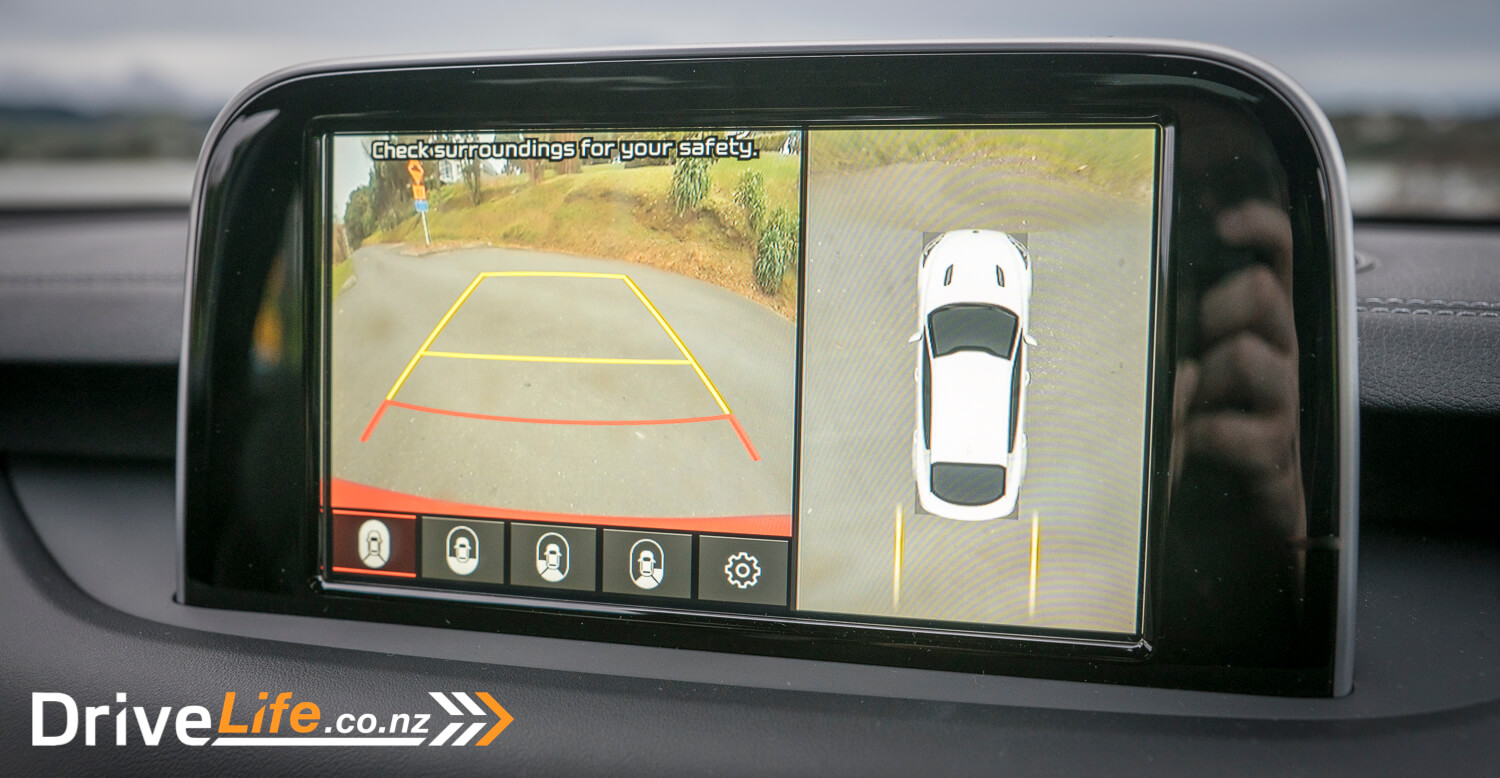
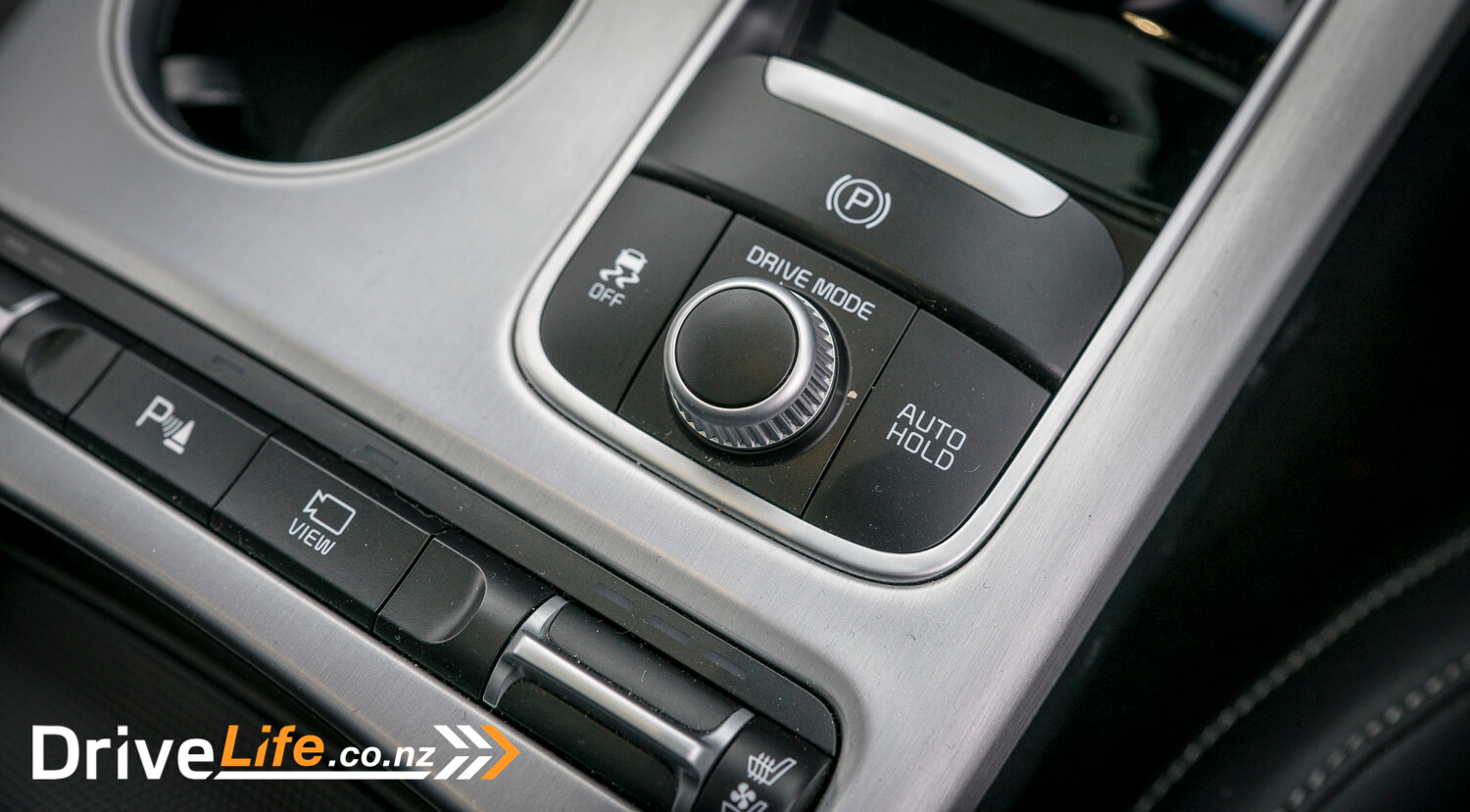
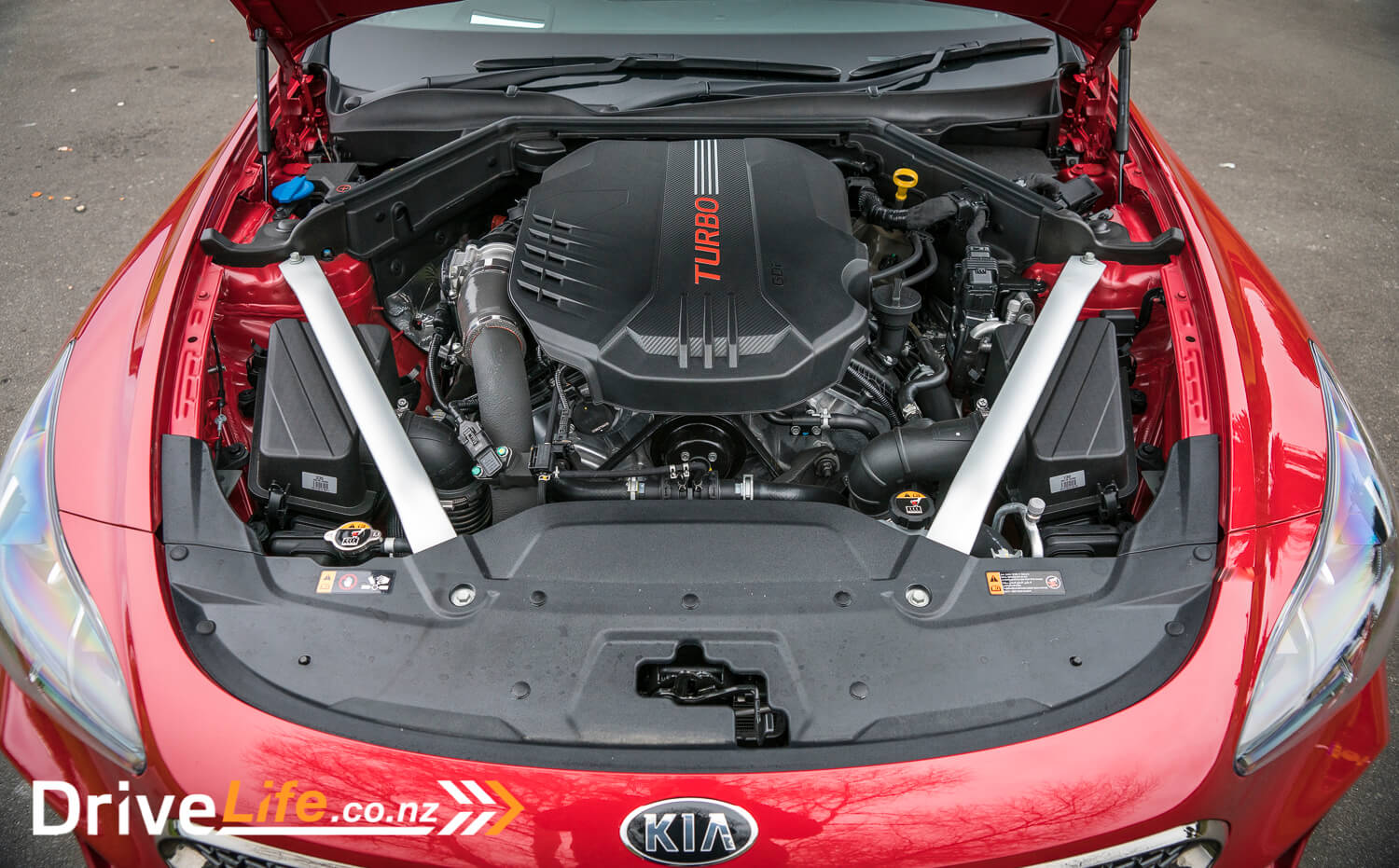
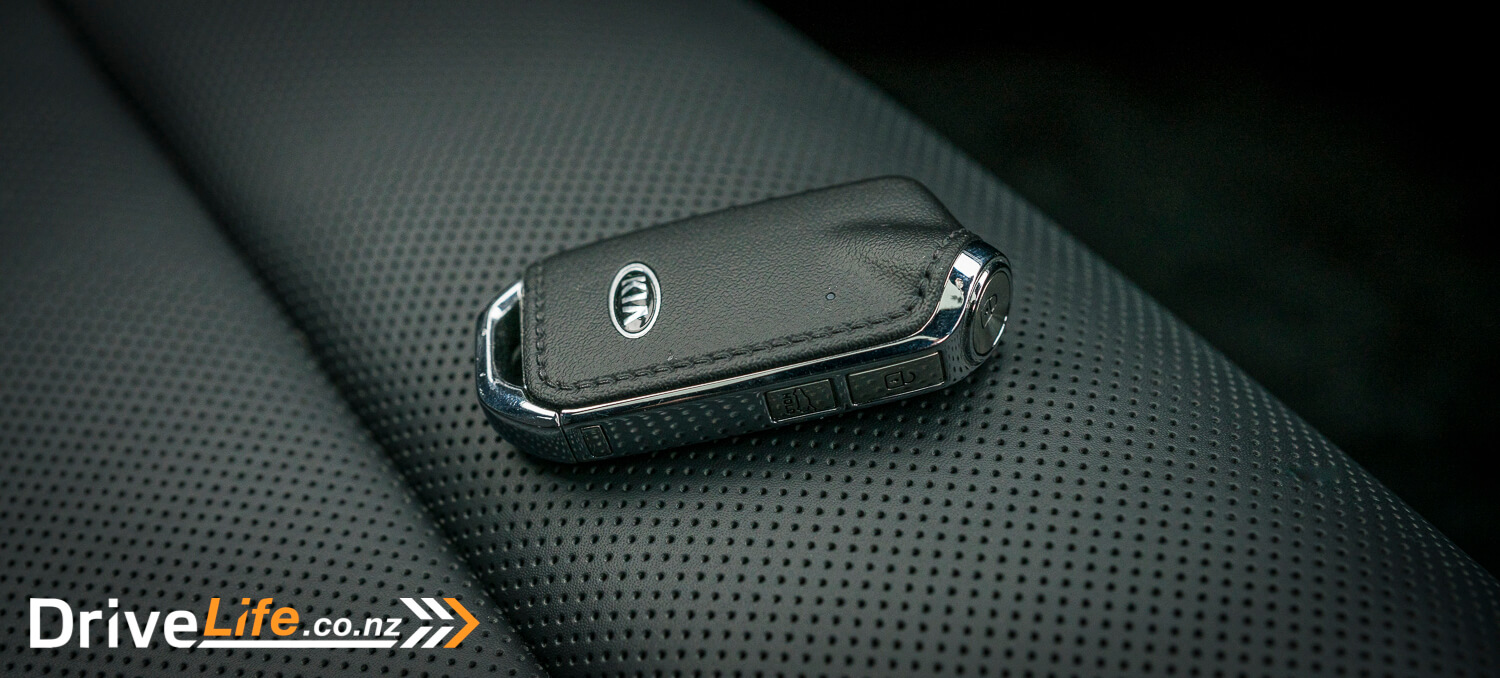

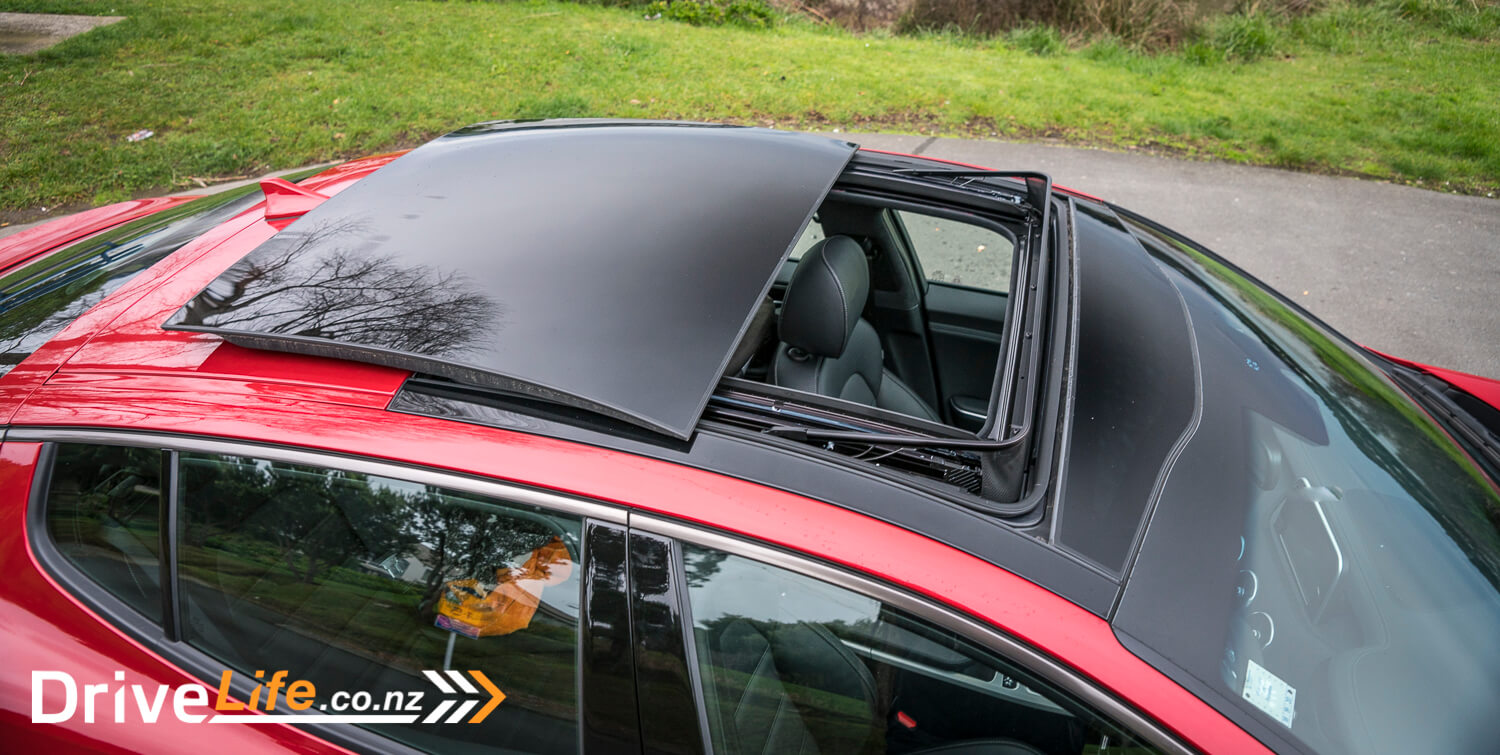
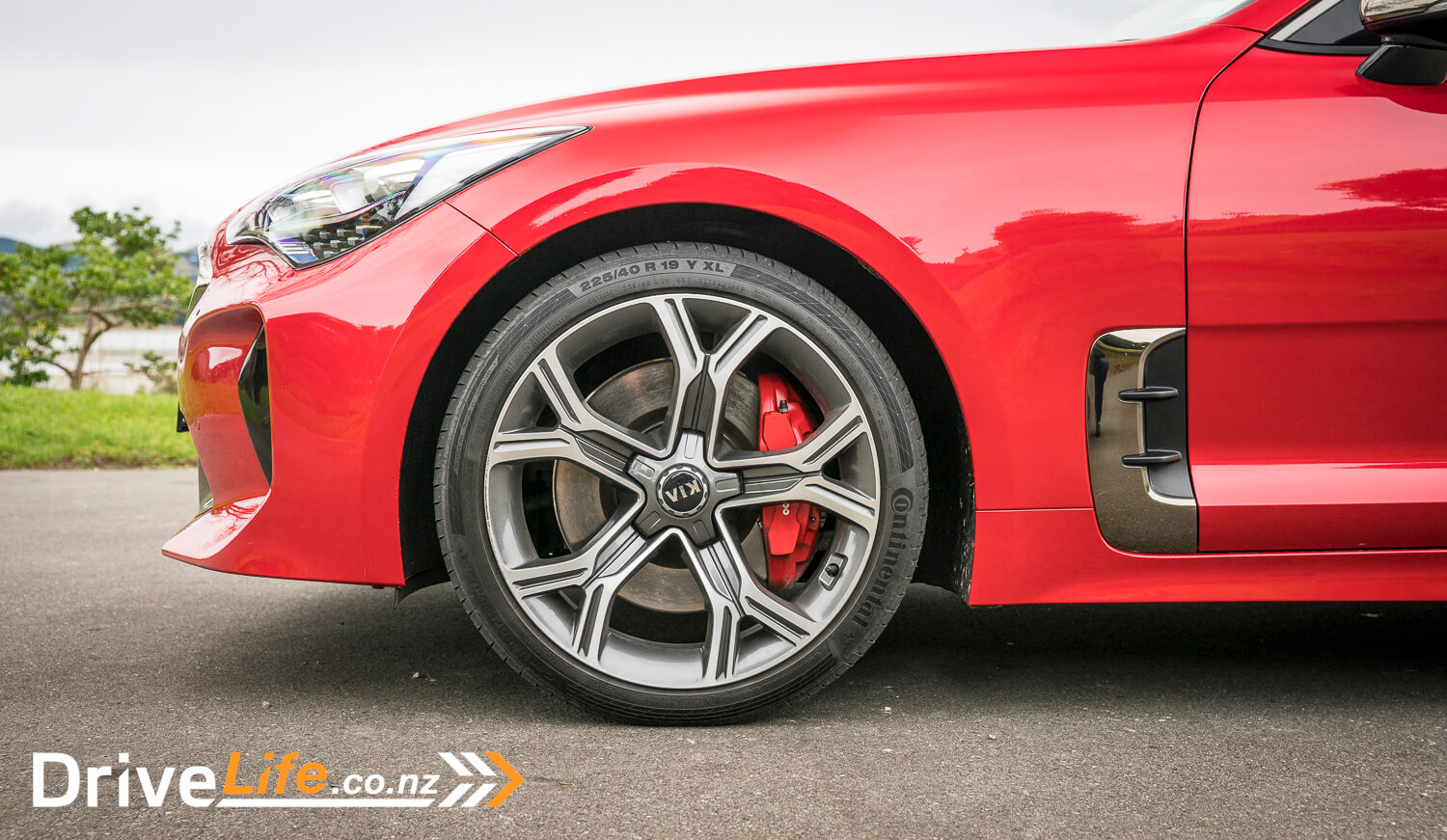
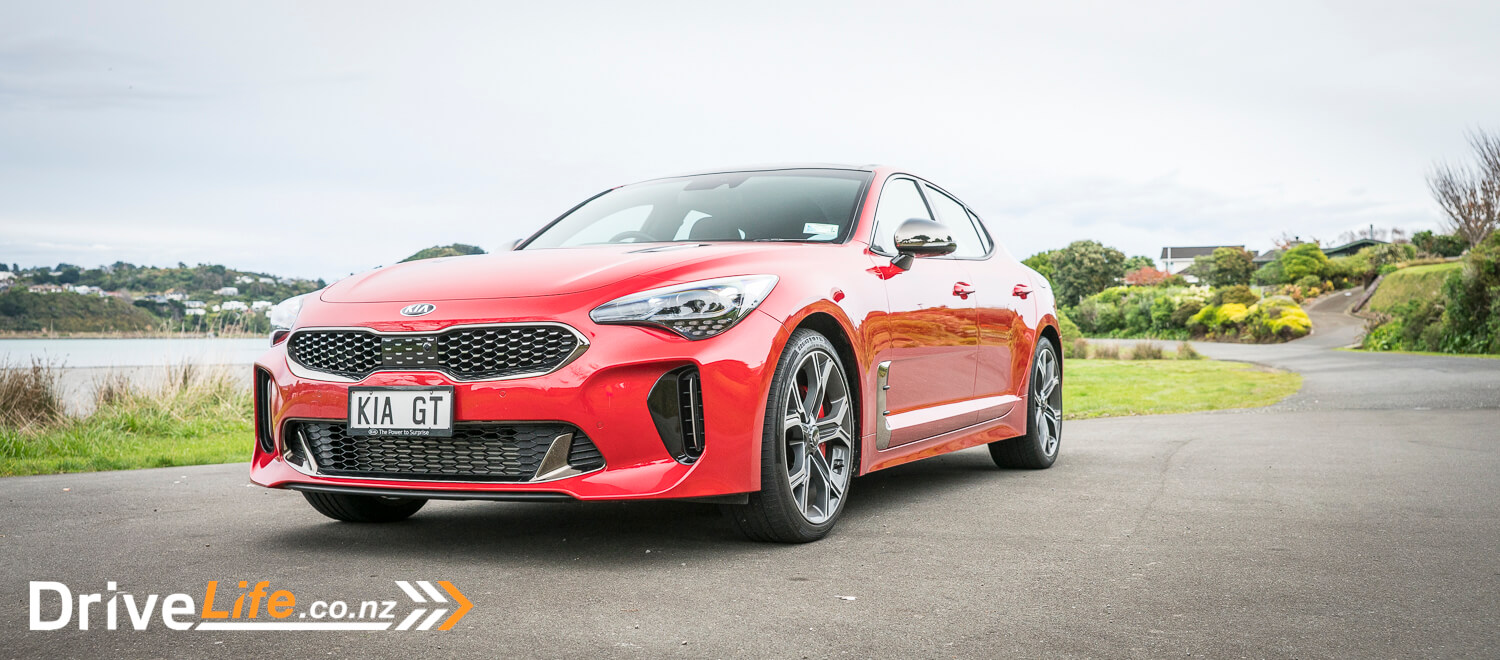












































I have just purchased the new Kia Stinger 3.3 twin turbo, I also have as a classic and very rare 2003 HSVGTS Coupe auto, which I have from new, done 25,000 kms
The Kia has a far better performance, and while I love the GTS, the Kia is just fabulous.
One major problem though with the Kia is you are sure going to get more speeding tickets as it is just so fast, 130 in no time, and quiet.
Hi Peter. It truly is a surprising product from KIA, power, performance, handling and great value for money. Its great to hear you are enjoying your new car.
“…When you lift the cover, the space saver spare wheel takes up a lot of space…”.
The reason why the space saver spare wheel appears to take up a lot of room is that interestingly the car’s battery is located underneath it. 🙂
The arrangement is interesting, having the car’s battery where the spare wheel would usually go, and then on top of the battery is the space saver spare wheel. Hence the reason why the boot capacity is not as large as it could be.
I do like the Kia Stinger GT. 🙂